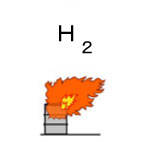| Case Name |
Leakage and fire of hydrogen from a mounting flange of a safety valve in a reactor at a succinic acid manufacturing plant |
| Pictograph |

|
| Date |
June 8, 1998 |
| Place |
Kawasaki, Kanagawa, Japan |
| Location |
Chemical factory |
| Overview |
During usual operation at a succinic acid plant, hydrogen leaked from a mounting joint of a safety valve at the upper part of a reactor, and a flame was generated. For inspection at a turnaround shutdown, the safety valve was detached and reattached. A gasket smaller than the correct gasket was used at the joint, and the tightening force of bolts was imperfect. Therefore, a gap was generated as time goes by and un-reacted hydrogen leaked. |
| Incident |
A hydrogeneration reaction of maleic anhydride for manufacturing succinic acid was finished. While an operator went to the site for confirmation, he found a flame jetting from a flange that joined a safety valve to a reactor. |
| Processing |
Manufacture |
| Individual Process |
Maintenance |
| Substance |
Hydrogen, Fig2 |
| Maleic anhydride, Fig3 |
| Type of Accident |
Leakage, fire |
| Sequence |
On May 9th, 1998. During a turnaround shutdown, a safety valve of a reactor was removed for inspection.
On May 16th. The safety valve was attached again with a fresh gasket.
On May 25th. An airtightness test at the joint was done.
12:15 on June 8th. Manufacture of succinic acid started. Raw materials were automatically charged to the reactor, and a reaction started.
15:05. The feed rate of hydrogen fell, and pressure rose. A low-temperature alarm sounded simultaneously.
15:10. An operator went to the site to open a steam valve. He found a pale flame from the upper part of the reactor.
A hose was immediately connected to the water service faucet and the fire was extinguished by spraying water.
The operation of the reactor was stopped and nitrogen gas was introduced to the reactor. Occurrence of the fire was reported to the office. |
| Cause |
A gasket smaller than the correct gasket was used at a joint of a safety valve at the time of a turnaround shutdown. Moreover, the tightness of bolts was imperfect. Due to the small size of the gasket and looseness of bolts, the weight of the piping was applied locally to the joint, and the joint inclined gradually. Un-reacted hydrogen blew out from a gap due to the inclination, and it was ignited by static electricity sparks. |
| Response |
Water was sprayed using a faucet.
Operation of the plant was stopped.
Nitrogen gas was introduced to the reaction system. |
| Countermeasures |
Thorough control of the parts at construction is required.
Bolts should be tightened equally and fully.
A new support for distributing the weight of piping is installed.
Thoroughness of checks after construction. |
| Knowledge Comment |
In many cases, it is difficult to find a mistake in construction after completion. It becomes important to make and manage a system that can reduce mistakes in construction. |
| Background |
There was a double mistake in construction management. Management of parts and tightening force of bolts was inadequate.
Moreover, a check after construction and a leak test were not useful as a result. |
| Incidental Discussion |
In the case of many leak tests after construction, a leak is checked by a soap test after pressurizing piping and facilities for the test. As a gasket and bolt torque are specified according to physical properties of a flowing liquid, temperature, long-term use, etc., passing of a leak test is not guaranteed for long-term use. Moreover, regarding a check of the tightness of bolts, checks in many cases conducted by striking a bolt lightly with a small hammer (called a hammering test). Measurement of torque has never been carried out. It is difficult to find a defect from a general examination after completion of construction.
Soap test; one of the leak tests. Soapsuds are poured at the place to be checked (mainly a joint part) after pressurizing. If bubbles are found, that is the evidence of a leak. |
| Reason for Adding to DB |
Example of fire caused due to misuse of a gasket |
| Scenario |
| Primary Scenario
|
Organizational Problems, Poor Management, Slackness of Management, Carelessness, Insufficient Understanding, Insufficient Recognition of Risk, Planning and Design, Poor Planning, Construction Control Planning, Usage, Maintenance/Repair, Restration, Malfunction, Poor Hardware, GasketLeakage, Secondary Damage, External Damage, Fire
|
|
| Sources |
Complex accidents from Jan.1 to Dec. 18: 71 cases. Informal total, Industry and protection, Vol.14, No.48, p.17 (1998).
The Res. Inst. of Industrial Safety material. (closed).
|
| Multimedia Files |
Fig2.Chemical formula
|
|
Fig3.Chemical formula
|
| Field |
Chemicals and Plants
|
| Author |
ITAGAKI, Haruhiko (Japan National Institute of Occupational Safety and Health)
TAMURA, Masamitsu (Center for Risk Management and Safety Sciences, Yokohama National University)
|
|